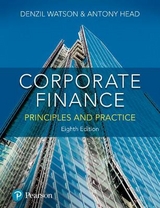
Corporate Finance
Pearson Education Limited (Verlag)
978-1-292-10303-7 (ISBN)
- Titel erscheint in neuer Auflage
- Artikel merken
Ortenca Kume, University of Kent
“Written in a refreshing, crisp and precise manner”
Jan Schnitzler, VU University Amsterdam
In this new and fully updated Seventh Edition of Corporate Finance: Principles and Practice, the key principles and mathematical techniques are clearly explained step–by-step and put into practice through numerous vignettes which take a closer look at real-world and well-known companies.
What’s new?
Chapter vignettes refreshed to reflect the current economic and financial climate,
along with accompanying questions aiming to deepen student's knowledge of key
contemporary issues
All data and tables updated to reflect current trends in key economic variables and
developments in corporate finance
Chapter 1 revised to reflect recent developments in corporate governance
Chapter 11 updated to take account of the changes in UK anti-trust regulation
Denzil Watson and Antony Head are Principal Lecturers in Sheffield Business School at Sheffield Hallam University. They have extensive experience of teaching corporate finance, managerial finance and strategic financial management in a wide range of courses at undergraduate, postgraduate and professional level.
Preface
Acknowledgements
1 The finance function
Learning objectives
Introduction
1.1 Two key concepts in corporate finance
1.2 The role of the financial manager
1.3 Corporate objectives
1.4 How is shareholder wealth maximised?
1.5 Agency theory
1.6 Corporate governance
1.7 Conclusion
Key points
Self-test questions
Questions for review
Questions for discussion
References
Recommended reading
2 Capital markets, market efficiency and ratio analysis
Learning objectives
Introduction
2.1 Sources of business finance
2.2 Capital markets
2.3 Capital market efficiency
2.4 Assessing financial performance
2.5 Conclusion
Key points
Self-test questions
Questions for review
Questions for discussion
References
Recommended reading
3 Short-term finance and the management of working capital
Learning objectives
Introduction
3.1 The objectives of working capital management
3.2 Working capital policies
3.3 Working capital and the cash conversion cycle
3.4 Overtrading
3.5 Managing inventory
3.6 Managing cash
3.7 Managing receivables
3.8 Conclusion
Key points
Self-test questions
Questions for review
Questions for discussion
References
Recommended reading
4 Long-term finance: equity finance
Learning objectives
Introduction
4.1 Equity finance
4.2 The stock exchange
4.3 Rights issues
4.4 Scrip issues, share splits, scrip dividends and share repurchases
4.5 Preference shares
4.6 Conclusion
Key points
Self-test questions
Questions for review
Questions for discussion
References
Recommended reading
5 Long-term finance: debt finance, hybrid finance and leasing
Learning objectives
Introduction
5.1 Bonds, loan notes, loan stock and debentures
5.2 Bank and institutional debt
5.3 International debt finance
5.4 Convertible bonds
5.5 Warrants
5.6 The valuation of fixed-interest bonds
5.7 The valuation of convertible bonds
5.8 Leasing
5.9 Evaluating the financial effect of financing choices
5.10 Conclusion
Key points
Self-test questions
Questions for review
Questions for discussion
References
Recommended reading
6 An overview of investment appraisal methods
Learning objectives
Introduction
6.1 The payback method
6.2 The return on capital employed method
6.3 The net present value method
6.4 The internal rate of return method
6.5 A comparison of the npv and irr methods
6.6 The profitability index and capital rationing
6.7 The discounted payback method
6.8 Conclusion
Key points
Self-test questions
Questions for review
Questions for discussion
References
Recommended reading
7 Investment appraisal: applications and risk
Learning objectives
Introduction
7.1 Relevant project cash flows
7.2 Taxation and capital investment decisions
7.3 Inflation and capital investment decisions
7.4 Investment appraisal and risk
7.5 Appraisal of foreign direct investment
7.6 Empirical investigations of investment appraisal
7.7 Conclusion
Key points
Self-test questions
Questions for review
Questions for discussion
References
Recommended reading
8 Portfolio theory and the capital asset pricing model
Learning objectives
Introduction
8.1 The measurement of risk
8.2 The concept of diversification
8.3 Investor attitudes to risk
8.4 Markowitz’s portfolio theory
8.5 Introduction to the capital asset prici
| Erscheinungsdatum | 16.06.2016 |
|---|---|
| Verlagsort | Harlow |
| Sprache | englisch |
| Maße | 191 x 248 mm |
| Gewicht | 872 g |
| Themenwelt | Wirtschaft ► Betriebswirtschaft / Management ► Finanzierung |
| ISBN-10 | 1-292-10303-5 / 1292103035 |
| ISBN-13 | 978-1-292-10303-7 / 9781292103037 |
| Zustand | Neuware |
| Haben Sie eine Frage zum Produkt? |
aus dem Bereich



